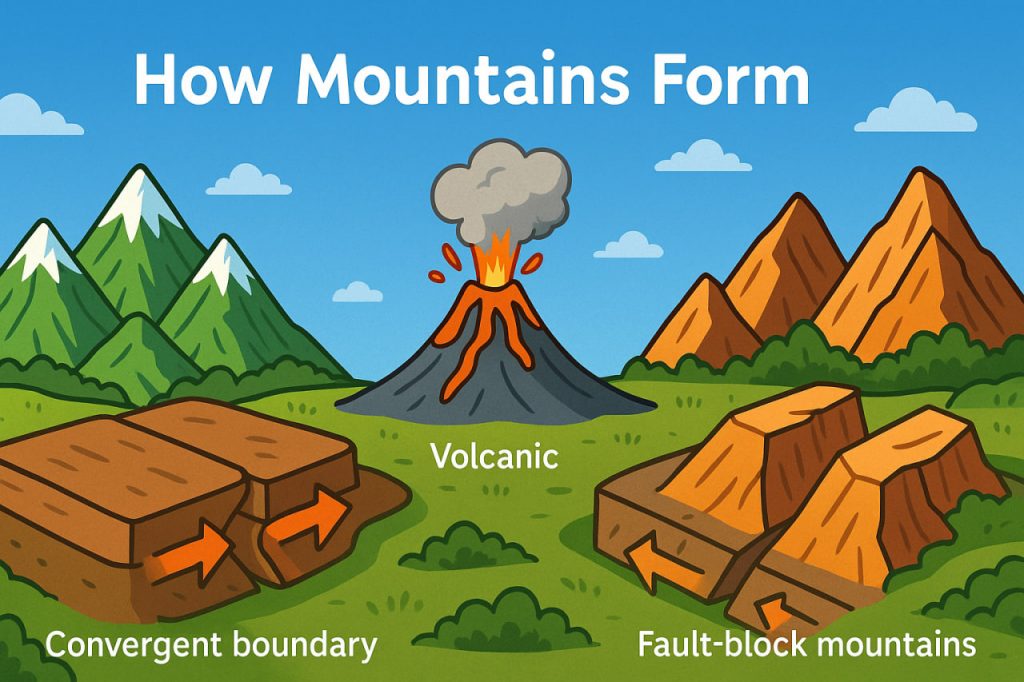Mountains are some of the most majestic and recognizable features on Earth, but their formation is the result of powerful and often slow-moving geological forces deep within the planet. From towering peaks like the Himalayas to ancient, eroded ranges like the Appalachians, mountains tell the story of a dynamic Earth in constant motion.
What Causes Mountains to Form?
Mountains are formed mainly through plate tectonics—the movement of large sections of the Earth’s outer shell, called tectonic plates. These plates float on the semi-fluid layer beneath them and constantly move, collide, or slide past each other.
There are three primary ways mountains form:
- Convergent boundaries (collision zones)
When two plates collide, the crust is pushed upward, forming fold mountains.
Example: The Himalayas formed from the collision of the Indian and Eurasian plates. - Subduction zones
When one plate slides beneath another, magma can rise to the surface, forming volcanic mountains.
Example: The Andes in South America. - Fault-block mountains
When tectonic forces pull the crust apart, large blocks of rock can be uplifted or dropped down, creating sharp peaks and valleys.
Example: The Sierra Nevada in the United States.
The Role of Erosion
Once a mountain is formed, it is gradually shaped by erosion—the action of wind, water, ice, and gravity. Over millions of years, erosion can:
- Smooth sharp peaks
- Create valleys and gorges
- Transport sediment to other parts of the landscape
This is why some mountain ranges, like the Rockies, are sharper and younger, while others, like the Appalachians, are older and more rounded.
Volcanic Mountains
Some mountains form from volcanic activity when magma rises through the Earth’s crust and erupts onto the surface. Over time, repeated eruptions build up layers of lava and ash, creating cone-shaped mountains.
Famous volcanic mountains include:
- Mount Fuji (Japan)
- Mount Kilimanjaro (Tanzania)
- Mount St. Helens (USA)
Volcanic mountains can grow quickly in geological terms but can also collapse or change shape after major eruptions.
Mountains Under the Sea
Not all mountains are visible on land. Many mountain ranges exist under the oceans, formed by similar tectonic forces. The Mid-Atlantic Ridge, for example, is a massive underwater mountain chain stretching thousands of kilometers along the ocean floor.
These undersea mountains can influence ocean currents and support diverse marine life.
Why Mountains Matter
Mountains are important for both nature and people:
- They store freshwater in snow and glaciers.
- They provide habitats for unique plants and animals.
- Many cultures rely on mountain ranges for spiritual, cultural, and economic reasons.
- They influence climate patterns and weather systems.
Protecting mountain ecosystems is vital as they face threats from climate change, deforestation, and mining.
Glossary
- Tectonic plates – Large sections of Earth’s crust that move and interact.
- Fold mountains – Mountains formed by the compression and folding of Earth’s crust.
- Subduction – When one tectonic plate moves beneath another.
- Erosion – The gradual wearing down of rocks by natural forces.
- Volcanic mountain – A mountain formed by lava and volcanic activity.


